Article by Haney Louka, photosby Jeff Wilson and courtesy of manufacturers
For a vehicle to be critically acclaimed and a success in the marketplace, it needs to be more than just the sum of its parts. Everything needs to come together for an occupant experience that tips the scales in its favour, whether or not it has one single feature or technology that allows it to excel. That rings true for the annual Canadian Car and Utility Vehicle of the Year awards presented by the Automobile Journalists Association of Canada (AJAC), where entrants are evaluated on hundreds of weighted data points being voted on by dozens of journalists during one blissful week in October.
But what about those individual technologies that have all the potential to be game-changers but tend to be overlooked by evaluators searching for the best overall package? That’s where AJAC’s Best New Technology award comes to the fore. Here, we get the opportunity to focus on efforts made by automobile companies in research and development to bring new technologies to the mass automobile market.
This is the chance for automakers to be recognized for their latest features on their own technological merit regardless of the package in which they’re wrapped. To qualify for consideration this year, the technology must be new and must be available in a 2014 mass-produced vehicle. New this year, though, is the categorization of the technology awards. In previous years, technology panel members have been forced to choose between an innovative new technology that could be enjoyed by a vehicle’s owner every day (2012’s winner was Chevrolet’s Voltec propulsion system) and one that might be responsible for saving lives (last year saw GM’s front centre airbag take the honours).
But, this is our award, and we make the rules. So, for the first time, AJAC’s Best New Technology award has been divided into two categories: safety and innovation. Now we don’t have to feel conflicted about wanting to reward, say, a new infotainment technology over an active safety feature that will reduce crashes.
Best New Technology, Innovation: Infiniti’s Direct Adaptive Steering (DAS)
This year’s winner in the Innovation category is certainly worthy of discussion, because it is truly a technology that changes everything, but its initial production application leaves much to be desired. Infiniti’s Direct Adaptive Steering (DAS) took the innovation honours because things will never be the same moving forward.
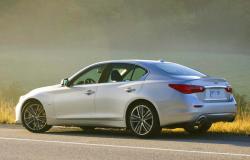 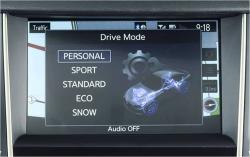 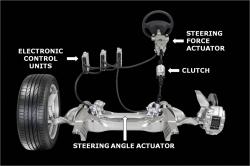 AJAC 2014 Technology Awards: Direct Adaptive Steering in the Infiniti Q50. Click image to enlarge |
For the first time in a production vehicle application, Infiniti has removed the mechanical linkage between the steering wheel and the front wheels, first introduced in the new Q50 sedan, which is the replacement for last year’s G37 sedan. DAS is standard equipment on the Q50 Hybrid and Q50S rear-drive sedan and optional on the Q50 and Q50S all-wheel-drive models. Also referred to as “steer-by-wire”, the technology has been employed to provide drivers with the combination of effort and response that suits them. In addition to several pre-programmed steering modes, Infiniti allows user-customized profiles to be created.
We can’t look too much at the packaging gains afforded by eliminating the mechanical linkage here because, for now at least, there is a backup mechanical linkage that will engage in the event of an electronic failure. But Tim Franklin, Infiniti’s senior manager of product planning points out that the days of the mechanical backup are numbered as the system evolves and consumer acceptance increases.
We can’t ignore the fact that a couple dozen models received a faulty software update that could lead to failure of the steering system in cold temperatures, and that in such cases the mechanical system may not engage quickly enough. Consumer acceptance will take forever – or may never materialize – if the software isn’t bulletproof.
And in addition to these issues, my limited wheel time in the Q50 with DAS revealed that when set to a sportier setting the response was too quick on centre which led to constant corrections to keep the thing pointed straight.
So we can get this out of the way right now: is the technology fully evolved to the point that it is superior to existing systems? No. But is it a noteworthy first step in a new direction worthy of being recognized as a significant innovation? Absolutely.
You may remember the first electronic stability control systems. They cut power and clamped the brakes so abruptly that it was a no-brainer to disable them during spirited driving. Now, depending on the application, the systems are so refined and unobtrusive that drivers are hard-pressed to recognize when the system is activated.
So here’s how DAS works: a sensor reads the steering wheel angle change initiated by the driver. The system’s electronic control unit (ECU) translates that into a command for the steering angle actuator, resulting in a change in angle of the front wheels. The required force to turn the wheels is read by the ECU and fed back into the steering wheel for the driver.
For redundancy, there are three ECUs, and there’s an electric clutch in the middle of the mechanical linkage that will default to engage the system in the event of a power disruption.
I know, I know. This is artificial. It’s more Gran Turismo 6 than anything a real driving enthusiast should be interested in, let alone rewarding. But consider this: steering kickback will be a thing of the past. Precise response on turn-in can be adjusted to a driver’s taste. There is a potential for weight savings and packaging efficiencies. And let’s not ignore the fact that the aviation industry has been using fly-by-wire systems for decades.
The steer-by-wire system facilitates other features like active lane control, reducing driver corrections due to road surface changes or high crosswinds.
Infiniti’s DAS was chosen over some worthy competitors: Honda’s “intelligent multi-mode drive” is a worthy evolution of the hybrid powertrain, but didn’t come through as significantly new enough to warrant top honours.
Similarly, Ford’s 1.0 EcoBoost takes the company’s existing turbocharged direct-injection technologies and applies them in a smaller package. A three-cylinder mill with 148 lb-ft of torque? Nice.
GM’s dynamic suspension spool valve is a new application in a production car, allowing designers to adjust bump and rebound settings for both high-speed and low-speed wheel motions. What that means is that damper stiffness can be increased dramatically to aid handling without the traditional sacrifice in ride quality.
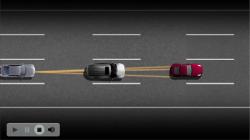 AJAC 2014 Technology Awards: Infiniti Predictive Forward Collision Warning (PFCW). Click image to enlarge |
Best New Technology, Safety: Infiniti Predictive Forward Collision Warning (PFCW)
The inaugural safety category was a bit of an oddity this year. Infiniti takes a double win this year, and this second one comes thanks to its Predictive Forward Collision Warning (PFCW) system. Its only competitor in the group was Mercedes-Benz, which entered no less than four technologies. And it’s not that any of those technologies is less deserving than Infiniti’s, but I think what ended up happening was that votes for Mercedes-Benz became diluted because of the number of entries it had. More on that in a bit.
PFCW is available on some AWD versions of the Q50, and the technology is a new application based on existing hardware. Infinitis have had forward-looking radar systems on their cars for more than a decade; the radar was in place to enable adaptive cruise control and distance control assist systems that focus on the car immediately in front.
But what is new this year is the system’s ability to see two vehicles ahead and warn if that vehicle begins to slow rapidly even if the driver can’t see the impending threat. Actually, it’s not the system’s ability to see that is new; that was always there but designers mistook the signal as noise until they started seeing some patterns. The system works especially well when a large vehicle with higher ground clearance like a cube van is immediately in front. The radar signal is transmitted underneath the cube van to the vehicle ahead and will begin to warn the driver if it decelerates beyond a certain threshold. The warning comes in the form of visual (instrument panel), audible (BEEP), and haptic (tightening the seatbelt) cues to make sure as many senses are engaged as possible.
What makes this technology a winner is its relative simplicity and low cost weighed against its merit as an active safety feature.
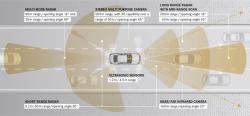 AJAC 2014 Technology Awards: Mercedes-Benz Intelligent Drive diagram. Click image to enlarge |
Mercedes-Benz wanted to make sure our safety ballots were full of entries this year. The suite of technologies the company entered is called Intelligent Drive, but it was broken down into individual entries, each of which uses the available technologies in different ways.
Pre-Safe Brake with Pedestrian Detection uses short and long wave radar plus a stereo camera to detect objects at speeds between 7 and 200 km/h. And at speeds up to 72 km/h, it can identify pedestrians. When a danger of collision is identified, an audible warning is emitted followed by partial braking if the driver fails to take action. If the driver still doesn’t respond, emergency braking is initiated.
In the case of pedestrians, immediate emergency braking is initiated which makes it possible to avoid a collision at initial speeds below 50 km/h.
BAS Plus uses the same technologies to identify potential collisions with cross traffic, and supplements driver braking with additional pressure if required to avoid a collision.
Pre-Safe Impulse is aimed at reducing occupant injuries in a crash. This is done by seat belt buckles and anchor fittings that work in conjunction with the reel tensioner in the B-pillar to tighten then gradually relax through the impact to reduce forces on occupants’ bodies. Construction workers benefit from the same concept when they use energy-absorbing lanyards as part of a fall-arrest system when working at heights.
Pre-Safe Plus looks behind the vehicle using radar sensors in the rear bumper. If a vehicle from behind is approaching too quickly, the system increases brake pressure to reduce the likelihood of launching the car forward. As with Pre-Safe Impulse, the seatbelt tension is adjusted to reduce loads on occupants’ bodies as well.
At the end of the day no single Mercedes-Benz safety technology was able to garner enough votes to emerge victorious over Infiniti; the company, however, is an undeniable presence in the industry as a frontrunner in the development and implementation of mass-market safety technologies.











